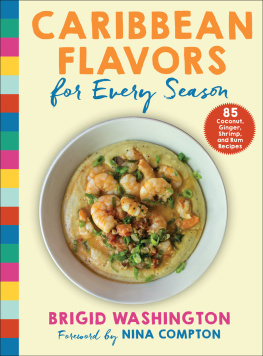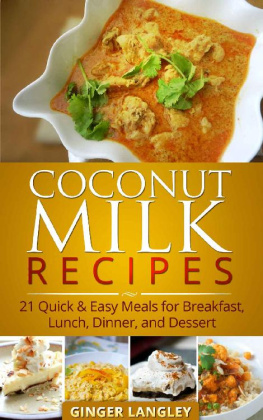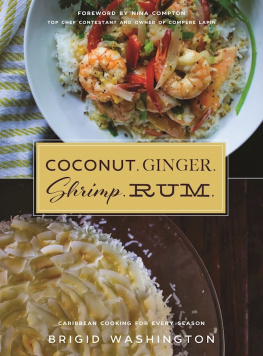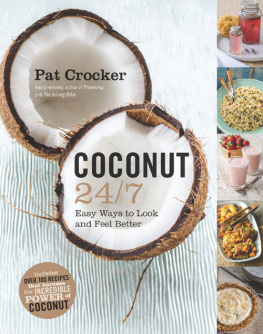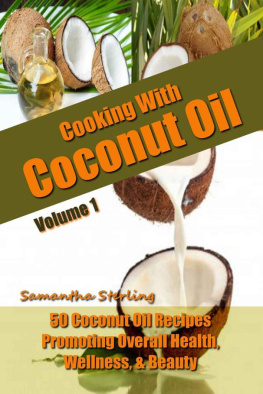



Copyright 2017, 2022 by Brigid Washington
Photographs 2017 by Immanuel Keester except photos for , which are copyright 2022 by Bonnie Matthews.
Illustrations 2017 by Erin Brown
Foreword 2017 by Nina Compton
Orginally published by Skyhorse Publishing under the title Coconut. Ginger. Shrimp. Rum.
All rights reserved. No part of this book may be reproduced in any manner without the express written consent of the publisher, except in the case of brief excerpts in critical reviews or articles. All inquiries should be addressed to Skyhorse Publishing, 307 West 36th Street, 11th Floor, New York, NY 10018.
Skyhorse Publishing books may be purchased in bulk at special discounts for sales promotion, corporate gifts, fund-raising, or educational purposes. Special editions can also be created to specifications. For details, contact the Special Sales Department, Skyhorse Publishing, 307 West 36th Street, 11th Floor, New York, NY 10018 or .
Skyhorse and Skyhorse Publishing are registered trademarks of Skyhorse Publishing, Inc., a Delaware corporation.
Visit our website at www.skyhorsepublishing.com.
10 9 8 7 6 5 4 3 2 1
Library of Congress Cataloging-in-Publication Data is available on file.
Cover design by David Ter-Avanesyan
Cover photograph by Immanuel Keester
Print ISBN: 978-1-5107-7053-9
Ebook ISBN: 978-1-5107-7150-5
Printed in China
For my mother, Anne Marie Ransome, the definition of self-sacrifice. If I inherit any of your traits, may it be your unfailing love for others and your grace under pressure.
And for Professor Dick J. Reavis, thank you for teaching me to discipline my writing and to believe in the power of journalistic persistence.


CONTENTS
Natures Opening Act
Late Nights & Endless Libations
Only God Could Create Those Colors
A Stiff Back; A Harbinger of Hope
Brand-New for the Paperback Edition

Photograph Elsa Hahne
FOREWORD
Growing up in the Caribbean, I think, was the best schooling as a chef. Most people have gardens, so farm-to-table is the way of life. There are numerous street vendors selling fruits and vegetables along the roadits the island grocery store, and you cant beat that. My fondest memory of growing up there was eating very sweet oranges at the beach during a family outing... I remember dipping the orange in the salt water; the combination of sweet and salty blew my mind. Or walking through the market and smelling all the fresh spices, such as cinnamon and bay leaves, perfume the air. The open markets in the Caribbean are such a beautiful sight for colorful fruit, vegetables, and fresh fish and butchered meats. Seeing and hearing people interact with their favorite local vendors contributes to the atmosphere as they joke, make mischievous comments, and catch up with one another, since everyone is so familiar. People in the Caribbean have so much history and each island is able to tell their own story through food. The many influences from early settlers such as English, French, Spanish, Indian, Dutch, and African, are interwoven through the islandseach sings its own individual song, but together make a beautiful harmony.
This book brings all of the above together. It expresses the fun, playful way of Caribbean people, along with the different cultures. Reading this book, I can taste the bright, bold flavors of these dishes. Rum is such a big part of the culture in the islands, and Brigid finds intricate ways to incorporate it into many recipes. Coconut is one of those ingredients that is used in a variety of ways in the Caribbean diet, whether using it as a cooking oil in savory applications, or in a sweet dessert, this a staple in our cooking. This book is fun and approachable, and really brings Caribbean cooking to the forefront where it belongs. Hopefully while cooking from this book, you are sipping on some delightful, aged rum!
Nina Compton, Top Chef runner up & fan favorite, owner & executive chef of New Orleans restaurant Compre Lapin

INTRODUCTION
Within the span of eighty recipes, borders are breached for you, the enterprising home cook. This book brims with relevant, upbeat, and deceptively simple ways you can marry the mouthwatering bounty of the four seasons to the bright flavors of the Caribbean table.
In writing this book, it became apparent that the greatest tragedy of Caribbean cuisine is misconception. Too often the food of the islands is translated to American restaurant tables as simple, fruit-forward fare; these tourist-friendly dishes portray a shallow concept of the West Indies rich and enduring culinary history. The narrative of the Caribbean is best told through the unfurled flags of the countries that once colonized the region. The settlers from those countriesboth indigenous and conquistadorstranslated their cuisines into a tradition, honing in on the wonts of their past whilst simultaneously bucking them to befit their new locale.
What happened next was probable. The island nations cultivated their distinct social norms and cash crops in ways that still strongly demark the socio-economic and cultural identity of each isle. The ill-fated identity of slavery and the burns of sugar were bonds of historical proportions. And even though time and technology have advanced the Caribbean agendafar beyond tourismeach island remains forever fused to the others, largely by traditions of a bygone era. But there remains a special brand of magic found in the islandsits people, and especially its food.
For you, I have written this book to be an approachable, buttoned-down way to incorporate an often misrepresented yet vibrant cuisine with the seasonal fare you already adore. The mezze, Roasted Cauliflower Coconut Tabbouleh, for instance, is equal parts delight and discovery. This recipe traces a path to the Mideast, making the cauliflower the star ingredient and without the use of fussy, far-flung ingredients.
In writing this book, I watched how old memories and recipes came to life beneath my fingers, connecting my past as a child and teenager in Trinidad & Tobago to my present life as a wife and mother of two in Raleigh, North Carolina. If nothing else, this project is a work of syncretism, integrating two worlds, through four ingredients. Within these pages, my goal is to elevate and celebrate the bounty of each American season in a way that salutes the taste of the tropics. And doing so requires a triage of, in my opinion, the most essential West Indian ingredients: coconuts, ginger, shrimp, and rum.
Next page
